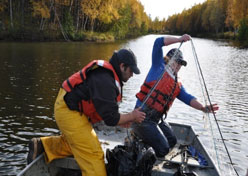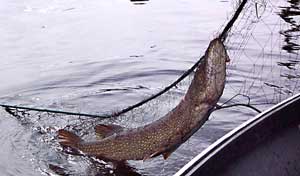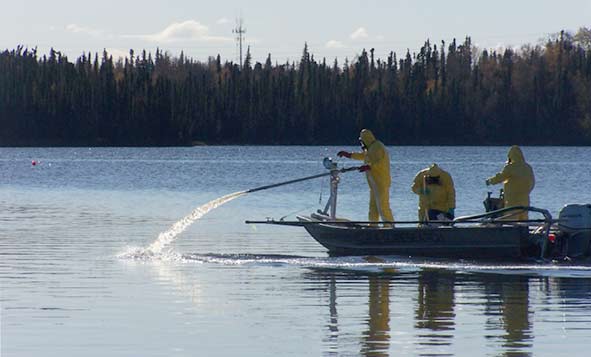Invasive Pike in Southcentral Alaska
What Can Be Done About Invasive Pike
Management Plan
ADF&G, along with partners in the Alaska Invasive Species Partnership (AKISP) - Invasive Northern Pike Committee, have developed a new management plan for northern pike in southcentral Alaska. This plan lays out a collaborative strategy to improve management capabilities for this invasive species.
Objectives of this plan are as follows:
- Minimize future intentional invasive Northern Pike introductions and reintroductions as well as spread to new waters.
- Increase public awareness of the invasive Northern Pike issue and support for management efforts.
- Implement scientifically sound management tools to detect, eradicate, contain, or suppress invasive Northern Pike populations.
- Restore fish populations that have been impacted by invasive Northern Pike introductions.
- Conduct research to fill knowledge gaps that currently impede management of invasive Northern Pike.
Public comments and feedback on this plan are encouraged. Please send comments to Kristine Dunker, ADF&G research fishery biologist and Chair of the AKISP Invasive Northern Pike Committee.
Current Management Plan (2022-2030): (PDF 16,928 kB)
ADF&G’s original northern pike management plan (2007-2021) remains available here: Management Plan for Invasive Northern Pike in Alaska (PDF 1,236 kB)
ADF&G encourages public comment on this plan. Please send comments to:
Kristine Dunker, Fisheries Biologist
333 Raspberry Road
Anchorage, Alaska 99518
Voice 907 267-2889
Fax (907) 267-2401
kristine.dunker@alaska.gov
Field Activities
The Department is removing invasive pike through gillnetting and other methods. These projects tend to be labor-intensive and must be repeated regularly to be effective. Netting does not usually eliminate pike completely. Young pike are most often found in very weedy areas, where fishing gear and nets are difficult to use, and pike must be moving to encounter the nets. Because pike are pretty sedentary when not spawning or feeding, catching all pike in a waterbody is unlikely. Still, there are cases where intensive gillnetting programs are the Department's best option for keeping invasive pike populations in check. For example, an large-scale invasive pike suppression program takes place annually in Alexander Creek in the Susitna River drainage. Some of the worst declines in salmon populations from pike predation have occurred in Alexander Creek, and ADF&G is trying to increase salmon productivity in this system through this effort.


The Department continues to investigate different methods of eradicating pike from Southcentral lakes. Currently, there are two effective methods to completely remove pike:
- Draining ALL the water or
- Applying a fish pesticide, such as rotenone.
Draining an entire lake may not be a realistic option for many lakes. Inlet and outlet streams have to be blocked or diverted. People with property around the lake are often very concerned about actions that raise or lower the water levels. In addition, the many required permits and processes greatly raise the expense and difficulty of draining the lakes that have illegally-introduced pike.
Rotenone, however, has been successfully used in fisheries management since the 1930s. Rotenone is a naturally-derived piscicide (fish pesticide) that has undergone rigorous review by the U.S. Environmental Protection Agency. It has been concluded that rotenone does not negatively affect human health or the environment in the concentrations used for fisheries management.
Still, the Department realizes there may be some concern about rotenone, and the Department is aware of those concerns. If rotenone is determined to be the best tool for removing invasive northern pike, the Department will fully engage the public decision-making process.

